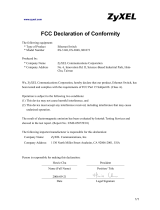
Table of Contents
NSW Series User’s Guide
5
3.3 LEDs ................................................................................................................................................ 24
Part II: Technical Reference...........................................................................27
Chapter 4
The Web Configurator........................................................................................................................28
4.1 Overview ......................................................................................................................................... 28
4.2 System Login ................................................................................................................................... 28
4.3 The Status Screen .......................................................................................................................... 29
4.4 Saving Your Configuration ............................................................................................................. 30
4.5 Switch Lockout ............................................................................................................................... 31
4.6 Resetting the NSW ......................................................................................................................... 31
4.7 Logging Out of the Web Configurator .......................................................................................31
4.8 Help ................................................................................................................................................. 31
Chapter 5
Status...................................................................................................................................................32
5.1 Status ................................................................................................................................................ 32
Chapter 6
Basic Setting.......................................................................................................................................34
6.1 Overview ......................................................................................................................................... 34
6.1.1 What You Can Do ................................................................................................................. 34
6.2 System Information ..................................................................................................................... 34
6.3 IP Setup ........................................................................................................................................... 36
6.4 Port Setup ....................................................................................................................................... 37
Chapter 7
VLAN....................................................................................................................................................40
7.1 Overview ......................................................................................................................................... 40
7.1.1 What You Can Do ................................................................................................................. 40
7.2 VLAN Status .................................................................................................................................... 40
7.2.1 VLAN Details ......................................................................................................................... 41
7.3 VLAN Configuration ...................................................................................................................... 41
7.4 Configure a Static VLAN .............................................................................................................. 42
7.5 Configure VLAN Port Setting ....................................................................................................... 44
Chapter 8
Maintenance......................................................................................................................................46
8.1 Overview ......................................................................................................................................... 46
8.1.1 What You Can Do ................................................................................................................. 46





















